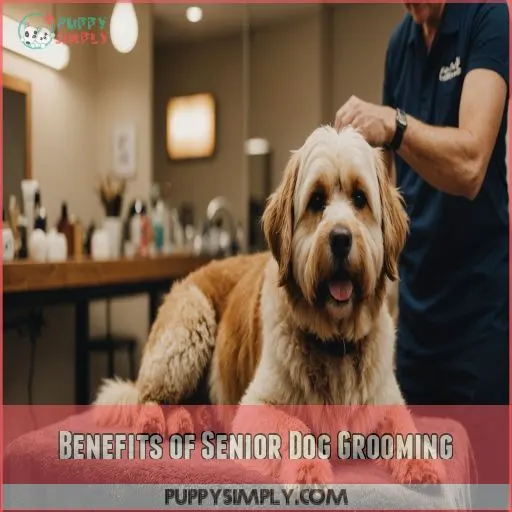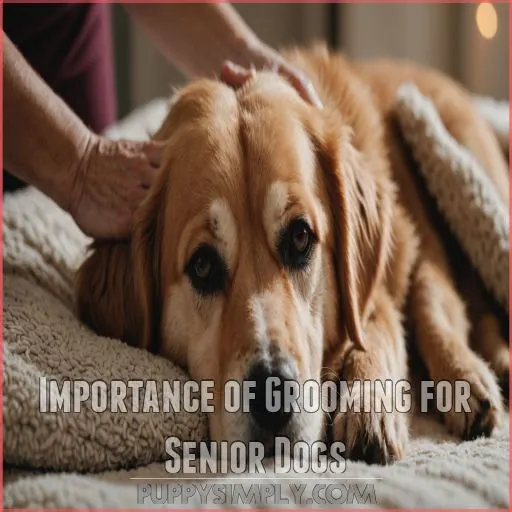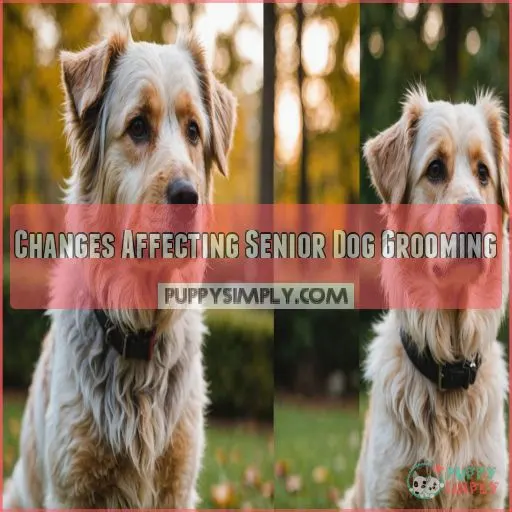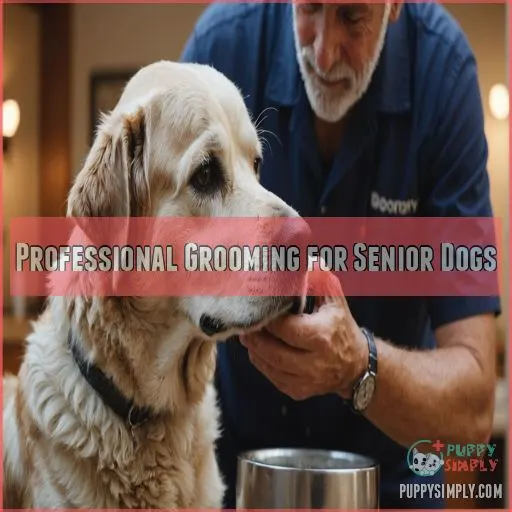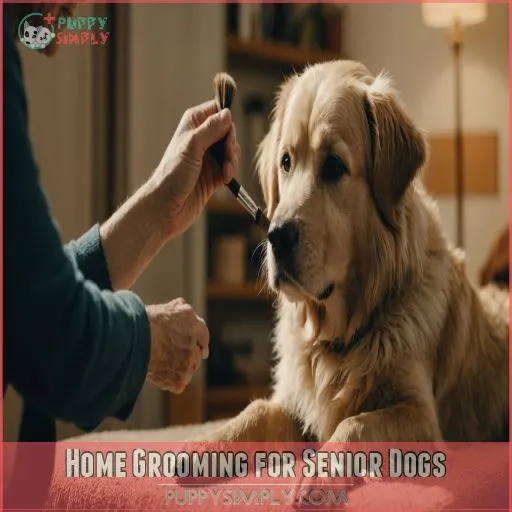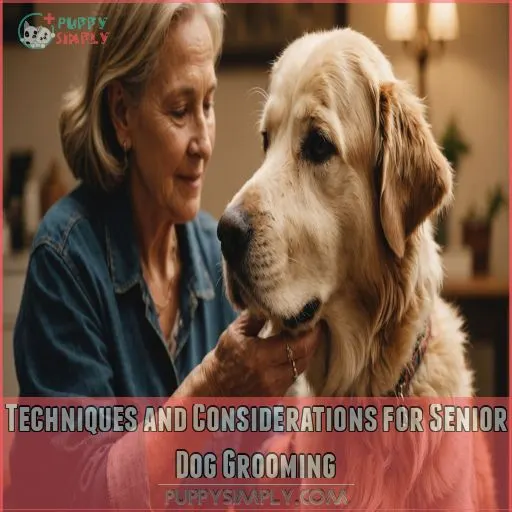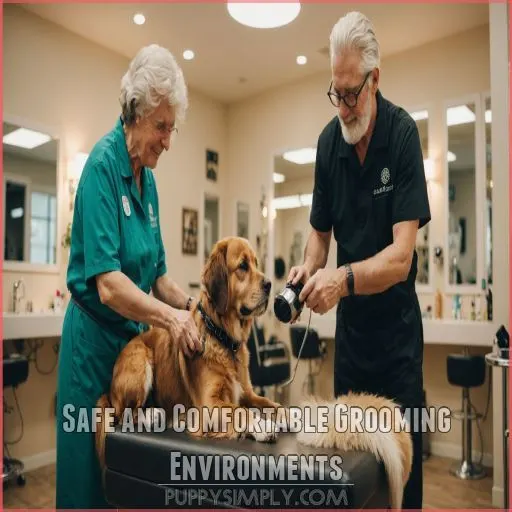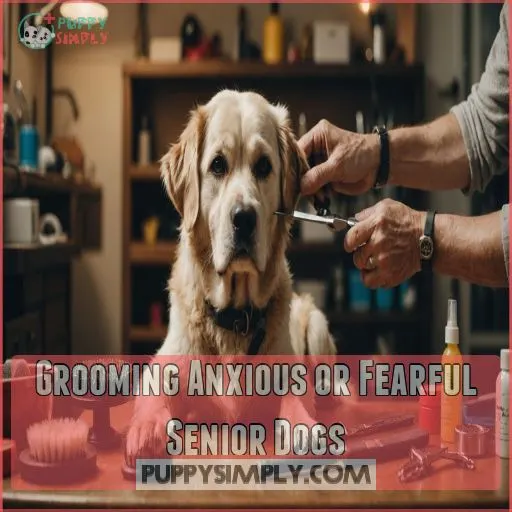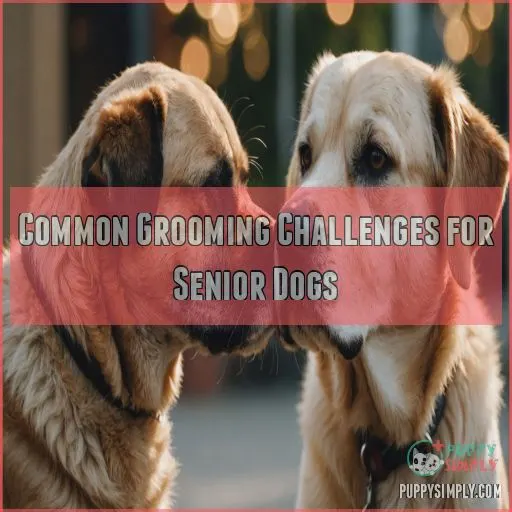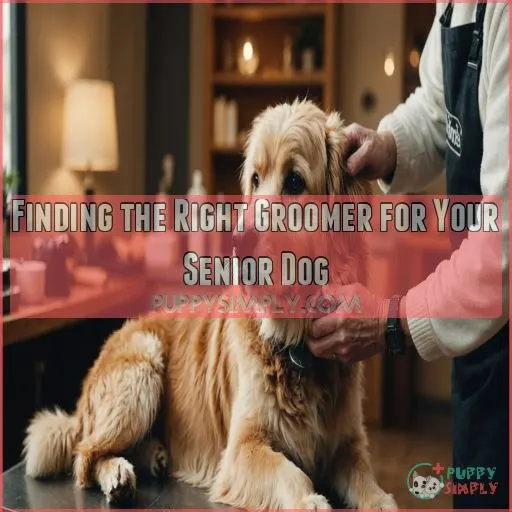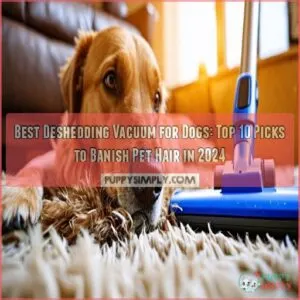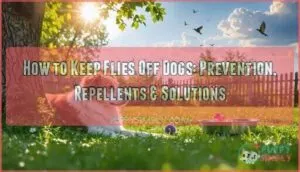This site is supported by our readers. We may earn a commission, at no cost to you, if you purchase through links.
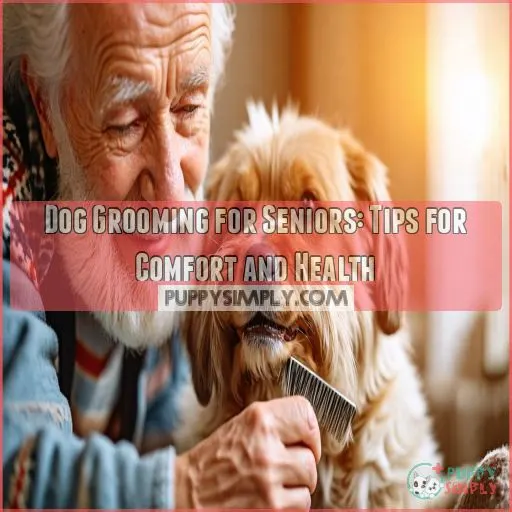
Regular grooming helps prevent skin irritation, infections, and those pesky mats. To keep stress levels low, consider a consistent routine and soothing techniques like gentle massages.
Mobile grooming services can do wonders by eliminating the stress of car rides. As your fur buddy ages, pay close attention to changes in their skin, weight, and mobility.
Pick a groomer who knows the ropes with older dogs, or pamper them yourself with gentle brushes and treats, making every grooming session a mini spa day. Curious for more tips, especially on managing stress levels?
Table Of Contents
- Key Takeaways
- Benefits of Senior Dog Grooming
- Importance of Grooming for Senior Dogs
- Changes Affecting Senior Dog Grooming
- Professional Grooming for Senior Dogs
- Home Grooming for Senior Dogs
- Techniques and Considerations for Senior Dog Grooming
- Safe and Comfortable Grooming Environments
- Grooming Anxious or Fearful Senior Dogs
- Common Grooming Challenges for Senior Dogs
- Finding the Right Groomer for Your Senior Dog
- Frequently Asked Questions (FAQs)
- How do you groom a senior dog?
- Can a senior dog be groomed at home?
- Why should you choose a senior dog groomer?
- Does your senior dog need a mobile grooming service?
- Should older dogs go to the groomer?
- How to groom a geriatric dog?
- How often should a senior dog bathe?
- Can you sedate an older dog for grooming?
- How to identify skin infections in senior dogs?
- What are signs a senior dog needs grooming?
- When to consult a vet during grooming?
- How to introduce new grooming tools safely?
- What are low-stress grooming techniques for seniors?
- Conclusion
Key Takeaways
- Grooming your senior dog at home can be a game-changer, reducing their stress and anxiety while eliminating the need for uncomfortable car rides. With in-home grooming, you can also keep a close eye on your pup’s health and ensure they’re comfortable throughout the process.
- Regular grooming is more than just a beauty routine; it helps maintain your senior dog’s health with proper senior dog multivitamins
. It keeps those pesky pests away and gives you a chance to spot any unusual lumps or bumps early, allowing for early detection of potential problems.
- When grooming your senior dog at home, creating a safe and comfortable environment is key to keeping them relaxed and content. Use non-slip surfaces, maintain a cozy temperature, and provide breaks as needed to ensure they remain relaxed and content.
- Helping your anxious senior dog feel at ease during grooming can be a bit like convincing a cat to take a bath, but with patience and gentleness, you can transform grooming anxiety into a rewarding experience. Use positive reinforcement, gradually increase touch and handling, and consider calming aids to make every session a spa-like retreat.
Benefits of Senior Dog Grooming
Grooming your senior dog at home can be a game-changer.
Reducing their stress and anxiety while eliminating the need for uncomfortable car rides.
With in-home grooming, you can also keep a close eye on your pup’s health and make sure they’re comfortable throughout the process, allowing for a more enjoyable experience of in-home grooming.
Reducing Stress and Anxiety
If your senior dog shows anxiety signals during grooming, try these calming techniques for a stress-free routine:
- Positive reinforcement: Praise and treats work wonders.
- Home remedies: Soothing scents or gentle massages.
- Routine: Same time, same place builds comfort.
- Understand their cues: Adapt as needed, like a dance partner.
These steps make senior dog grooming a peaceful experience.
Eliminating the Need for Car Rides
Reducing stress and anxiety is key for your senior dog’s well-being.
Skipping car rides for grooming does wonders for them. You know how they can fret like a cat in water with car anxiety.
Try mobile grooming instead. It’s a win-win—eliminate stressful rides, boost senior dog mobility, and welcome the joy of stress-free grooming right at home.
Decreasing Fatigue and Pain
Gentle handling during senior dog grooming eases pain and decreases fatigue, ideal for breeds with hypoallergenic needs like small senior dogs
.
By focusing on pain relief and exercise limits, you can make sure your arthritic or sensitive dog feels more comfortable.
Comfort cuts are great for keeping fur manageable, while mobility aids prevent strain.
With these dog grooming tips for seniors, you’ll help your dog stay happy and healthy through regular small breed care
.
Monitoring Vital Signs
After reducing fatigue and pain, you’ll want to keep an eye on your senior dog’s important signs during grooming. Monitoring helps you catch issues early.
Here’s what to track:
- Temperature and heart rate: Keep your buddy’s warmth in balance.
- Respiratory rate: Notice any changes in breathing.
- Weight and blood pressure: Identify underlying health problems.
Importance of Grooming for Senior Dogs
You know how your senior dog might struggle with tangles or skin issues?
Regular grooming is more than just a beauty routine; it helps maintain health.
It keeps those pesky pests away, and gives you a chance to spot any unusual lumps or bumps early, allowing for early detection of potential problems.
Maintaining Health and Happiness
You know, regular grooming isn’t just about looks—it’s about keeping your senior dog healthy and vibrant.
A good brush or bath boosts their spirits and comfort, much like a relaxing spa day.
It supports their sensitive skin and can reveal hidden issues early.
Plus, it complements a senior dog diet and exercise routine beautifully, keeping tails wagging like the ones highlighted in this article
.
Preventing Skin Irritation and Infections
Skin irritation and infections can be a real concern for senior dogs.
Certain breeds may be prone to yeast or staph infections.
Bathing with a gentle, hypoallergenic shampoo can soothe itchy skin, while regular grooming allows you to spot any changes that could indicate a problem.
Work closely with your vet to manage your pup’s skin health .
Controlling Shedding and Knots
Grooming senior dogs helps you control shedding and knots, keeping their coats healthy and beautiful. Daily brushing removes loose fur and prevents those pesky tangles. Use the right tools and techniques to tame their shedding patterns while making it enjoyable for both of you!
Don’t sweat the fur battles; here’s your grooming toolbox:
- Grooming tools
- Brushing techniques
- Shedding patterns
- Knot prevention
- Senior coat care
Checking for Signs of Trouble
Beyond managing shedding and knots, grooming uncovers hidden health signals like weight changes or skin issues.
You’ll easily notice lumps or persistent ear infections, which are common red flags in senior dog health.
Imagine it as a detective game—you’re gathering clues for your dog’s well-being.
It’s like playing Sherlock Holmes with fur, without the funny hat!
Changes Affecting Senior Dog Grooming
As your dog ages, you’ll notice changes that can make grooming more challenging.
Like arthritis that makes standing difficult or vision issues that increase anxiety.
Understanding these issues can help you approach grooming with patience and adapt to your dog’s needs.
Offering a few extra cuddles along the way to ease their stress.
Arthritis and Mobility Issues
Senior dogs can feel like they’ve just finished a marathon after grooming.
So, let’s make it easier for them by incorporating some helpful modifications:
- Use comfortable grooming surfaces.
- Explore senior dog mobility aids.
- Manage arthritis pain with joint support supplements.
- Keep grooming sessions short.
- Offer breaks as needed.
These tips help your furry friend stay happy and comfy! .
Vision Problems and Sensitivity
Your senior dog’s vision mightn’t be what it used to be, making grooming a bit tricky.
Use calming strategies and gentle communication methods.
Opt for visual aids to help them feel secure.
Sensory adjustments, like soft lighting, can work wonders.
When grooming at home or using services, tailor routines to accommodate their sensitivities, ensuring comfort and trust.
Dementia and Confusion
When dealing with dementia and confusion in senior dogs, grooming can become tricky. Keep things simple and consistent to help your furry friend feel secure.
Try these strategies:
- Routine: Stick to familiar grooming routines.
- Patience: Use soothing words and tones.
- Communication tips: Offer verbal cues before touching.
- Grooming skills: Use gentle, slow techniques for comfort.
Stay compassionate and understanding.
Aches and Pains
Ah, those aches and pains – they can really slow down your senior pup during grooming. But don’t worry, there are ways to make it easier.
Recognizing canine discomfort is key to addressing these issues, and it’s important to inform your veterinarian about any changes in behavior or physical symptoms, such as restlessness, decreased playfulness, or avoiding usual activities, to create a tailored pain management plan.
Try gentle massage to soothe sore joints, and consider joint supplements to provide relief (Source).
With a little extra care, you can keep your dog comfortable and happy during their grooming sessions.
Professional Grooming for Senior Dogs
For professional grooming for senior dogs, finding the right groomer who understands your pet’s unique needs is essential to keeping them comfortable and happy.
Book the first appointment of the day to avoid unnecessary stress, and don’t hesitate to discuss mobility issues and haircut preferences with your groomer.
After all, you’ve got to keep Fido’s dignity intact!
Choosing the Right Groomer
To find the perfect groomer for your senior dog, seek out one with proven qualifications and a knack for communication.
Trustworthy groomers have the experience necessary but also understand elderly dogs’ needs. They know how to provide a safe and comfortable environment.
Check reviews to see if they offer reasonable pricing and quality grooming services.
Booking the First Appointment of the Day
You’ve picked the right groomer; now grab that early bird slot for the first appointment of the day. It reduces stress for your senior dog, offers minimized distractions, and lets groomers prep with fresh energy.
Your dog will enjoy a calm experience with fewer interruptions.
- Less stress: Quiet start
- Fresh groomer: First-day advantage
- Fewer distractions: Uninterrupted focus
Selecting a Senior-Dog Friendly Haircut
When selecting a senior-dog friendly haircut, you should consider comfort cuts that cater to your dog’s coat type and mobility needs, taking into account their lifestyle and age, similar to how you’d consider best haircuts for golden retrievers.
For example, older Golden Retrievers may benefit from shorter cuts due to joint health issues. A shorter style can keep your pup cool and reduce grooming stress.
Use grooming tools and techniques that are gentle, ensuring your furry friend feels at ease. Remember, even an old dog deserves to look dapper and feel comfy!
Discussing Mobility Issues and Alternatives
Caring for a senior dog involves understanding their mobility issues. Consider alternatives to traditional grooming tables.
Here’s how you can help:
- Grooming Table Alternatives: Try a sturdy household table with a non-slip mat.
- Senior Dog Lifting: Use ramps for dogs to reduce strain.
- Bath Aids and Specialized Clippers: Invest in tools designed for gentle handling.
Home Grooming for Senior Dogs
Grooming your senior dog at home isn’t just convenient, it’s a chance for some extra bonding time.
Without the hassle of car rides, you can keep them looking and feeling their best.
With gentle techniques, you can save both stress and mileage, and your vet bills might even thank you!
Brushing Teeth and Cleaning Ears
Brushing your senior dog’s teeth and cleaning their ears are essential for their dental and ear health, especially with proper dog dental care at home
.
Start by using a soft-bristled toothbrush and dog-safe toothpaste. Gently lift their lips and brush in short strokes.
For ears, use a damp cloth to wipe away any debris. Be patient and reward your pup – they’ll soon get used to this routine!
Trimming Fur and Maintaining Hygiene
While keeping your senior dog’s teeth and ears clean, focusing on fur trimming and hygiene is just as important.
Use grooming tools like thinning shears and clippers to maintain a neat coat, especially around the backside.
This "poop path" prevents unwanted messes.
Keep the mood light—think of it as giving your dog a stylish trim.
Spot Cleaning and Bathing
Imagine your senior dog fresh as a daisy using spot cleaning and bathing methods.
Here’s a quick guide:
- Use waterless shampoos for those tricky areas.
- Keep bathing frequency low to prevent skin sensitivity.
- Master spot cleaning techniques using wipes or a damp cloth.
- Focus on hygiene maintenance to boost comfort and health.
Using Calming Aids and Gentle Techniques
After spot cleaning your furry friend, consider using calming aids designed for seniors to ease anxiety during grooming. Soft chews with ingredients like chamomile and melatonin can work wonders (Source).
Pair these with gentle brushing to give your dog a spa-like experience.
Safe nail trims and careful ear care make grooming a breeze, adding comfort to your dog’s routine.
Techniques and Considerations for Senior Dog Grooming
Grooming your senior dog at home requires a gentle touch and a bit of patience.
Especially with their sensitive skin and nails, it’s essential to be mindful of their well-being.
You’ll master techniques like soft brushing and careful ear cleaning, all while keeping their well-being in mind.
With a few treats for bribery, of course, you’ll be able to provide the best care for your senior dog.
Gentle Brushing and Combing
Gentle brushing is like giving your senior dog a mini spa day.
It keeps their coat healthy, helps detangle knots, and promotes bonding. Use soft brush types suited for their coat care.
Regularly brushing reduces shedding impact and maintains grooming results.
Try calming techniques; your gentle touch brings grooming outcomes that soothe both of you, creating positive grooming effects.
Assessing Skin Sensitivity and Irritation
As you gently brush your senior pup, keep an eye out for signs of skin irritation.
Look for redness, flakiness, or sensitivity.
Common culprits could be allergies, infections, or harsh grooming products.
Stick to gentle, fragrance-free shampoos and moisturizers to soothe their delicate skin, especially with the use of fragrance-free shampoos.
If you notice any issues, consult your vet for proper treatment.
Safe Nail Trimming Practices
Spotting itchy areas might remind you your pup’s nails need trimming too!
Choose the right clipper type to manage nail growth without pain. Use a proper technique, avoiding the sensitive quick to make sure your dog is comfortable.
Safety tips, like having treats on hand, can help transform this task into dog grooming for grooming satisfaction and fulfillment.
Ear Care and Cleaning
After mastering safe nail trimming, let’s tackle ear care
.
Keep an eye on ear infections and pesky ear wax. Use pet-friendly cleaning tools—never Q-tips—to avoid damage.
Home remedies might help, but always seek vet advice if you’re unsure. Remember, dog grooming for dogs with ear issues is like music to their ears, preventing troubles before they start.
Safe and Comfortable Grooming Environments
When grooming your senior dog at home, creating a safe and comfortable environment is key to keeping them relaxed and content.
Use non-slip surfaces and make sure the room is a cozy temperature, taking breaks as needed to adjust based on their comfort and energy levels, ensuring they are always relaxed and content.
Creating a Quiet and Familiar Space
To make grooming smoother for senior dogs, create a quiet space filled with familiar scents and calming music.
Use comfortable bedding to help them feel at home. Minimize distractions by choosing a peaceful area where you can focus on gentle care.
You might even add their favorite toy to keep their tail wagging happily throughout the grooming session.
Using Non-Slip Surfaces and Comfortable Temperatures
When grooming your senior dog, make sure the area has non-slip surfaces like yoga mats for floor safety. Maintain a comfortable temperature to ease that grooming anxiety.
Imagine wearing wet socks on a slippery floor—not comfy, right?
A safe environment enhances senior dog comfort, helping them relax and enjoy the experience more, while you confidently manage their needs.
Providing Breaks and Adjusting Priorities
Imagine grooming your senior dog as more of a gentle waltz than a sprint.
Frequent breaks during sessions help, especially when arthritis is the uninvited dance partner.
Adjust your routine, prioritizing comfort over haste. A little patience goes a long way in making grooming enjoyable and less stressful.
Remember, slow and steady does indeed win this race.
Monitoring for Signs of Stress and Discomfort
Keeping an eye out for subtle body language cues, like panting or lip licking, can help you spot when your senior pup is feeling stressed during grooming. Pay attention to any changes in vocalization or behavior, too – if they seem uncomfortable, take a break and try again later.
Utilizing a gentle and effective brush, such as a bamboo pet metal pin brush, can make the experience more pleasant for your dog.
Additionally, ensuring their safety during nail trimming with products like Kwik-Stop Styptic Powder can also help reduce stress. Your dog’s wellbeing is the top priority (Source).
Grooming Anxious or Fearful Senior Dogs
Helping your anxious senior dog feel at ease during grooming can be a bit like convincing a cat to take a bath—patience and gentleness are key.
You’ll want to introduce grooming tools slowly and reward your furry friend with treats and praise to create a calm, positive experience.
Introducing Grooming Tools and Techniques
Almost any older dog can become comfortable with grooming tools, even if they’re initially anxious. Start by introducing items slowly, allowing sniffing and exploration. Use calming techniques like soft music to ease nerves. Desensitize them by touching the tools to their body without using them immediately. Before long, they’ll be as cool as a cucumber with grooming.
For anxious dogs, consider using a guillotine trimmer with a safety guard Dog Nail Trimming Techniques, which can help make nail trimming a more positive experience. Additionally, associating nail trimming with positive reinforcement can help reduce stress and anxiety.
- Gentle brushing
- Quiet clippers
- Soft towels
- Calm surroundings
Using Treats and Praise for Positive Associations
During grooming, use treats and praise to create positive associations for your anxious senior dog. With positive reinforcement, you can transform grooming anxiety into a rewarding experience.
Here’s a quick guide:
| Step | Action | Reward |
|---|---|---|
| Calm State | Begin grooming | Offer a treat |
| Relaxed Vibe | Continue grooming | Praise softly |
| Maintain Calm | Finish session | Extra treat and cuddles |
Building trust takes patience and love.
Gradually Increasing Touch and Handling
Imagine your senior dog’s grooming experience evolving into a spa retreat with a bit of patience and practice.
Start by slowly increasing your touch, making them feel safe and loved.
Focus on:
- Gentle brushing using soft tools
- Short, calm sessions with breaks
- Positive reinforcement with treats
- Regular, friendly handling exercises
This gradual approach builds trust and reduces fear.
Considering Calming Aids and Alternatives
Is your senior dog jittery during grooming?
Consider calming music or gentle handling to soothe their nerves. Supplements can take the edge off, while anxiety meds might be necessary for extreme cases.
Pheromone sprays also create a relaxing environment without a hitch.
Remember, each dog is unique—try different methods to find what works best for your furry friend.
Common Grooming Challenges for Senior Dogs
Grooming your senior dog can sometimes feel like trying to knit a sweater with yarn that has a mind of its own, especially when dealing with matted fur or skin irritation.
Throw in challenges like incontinence, weight changes, and vision or hearing loss, and you’ve got a doggy grooming puzzle that demands extra care and compassion.
Matted Fur and Skin Irritation
Matted fur can be a real nuisance for senior dogs.
To prevent it, brush your pup regularly, keep their coat trimmed, and consider professional grooming.
If mats do form, don’t try cutting them out – that can injure your dog.
Instead, visit your vet or groomer, who can safely remove the mats and prevent skin irritation.
Incontinence and Hygiene Issues
After tackling matted fur, it’s time to face incontinence issues with senior dogs.
Use incontinence products and cleaning solutions to manage accidents. Regular cleaning with the right hygiene tips helps prevent skin irritation and odors.
Don’t forget to arm yourself with grooming tools to maintain health easily.
Keep a sense of humor; even dogs have their quirks! Managing incontinence can be frustrating, but it’s essential to remember that accidents are a natural part of the aging process, and having the right mindset, such as having a sense of humor, makes all the difference.
Weight Changes and Lumps
Weight changes and lumps might seem like small hiccups in grooming, but they’re worth a watch. They often whisper secrets about senior health.
- Weight Monitoring: Track changes regularly.
- Lump Detection: Feel for any new bumps.
- Diet Changes: Adjust meals as needed.
- Vet Visits: Stay proactive with appointments.
Keep your furry friend feeling top dog!
Vision and Hearing Loss
Spotting lumps is tricky, but noticing vision and hearing loss? That can be even hairier!
Keep your pup comfy by using grooming adjustments. Think sensory aids like scent trails and visual cues to ease stress.
Here’s a handy table to help:
| Issue | Solution | Safety Tips |
|---|---|---|
| Vision Loss | Scent Trails | Clear Pathways |
| Hearing Loss | Visual Cues | Use Lights |
| General Anxiety | Consistent Routines | Avoid Startling |
Remember, patience and consistency work wonders!
Finding the Right Groomer for Your Senior Dog
When finding the right groomer for your senior dog, consider their expertise and experience with older pets, as your furry friend carries a few extra miles on those paws. Look for someone with strong communication skills, who listens and addresses any concerns you might have. Don’t shy away from peppering them with questions.
Convenience matters too—choose a groomer close by to minimize stressful car rides. For example, some dog grooming services offer mobile grooming services that bring the salon to your doorstep, providing an added layer of comfort and convenience.
Additionally, you may want to inquire about their experience with breed-specific grooming techniques, as this can be particularly important for senior dogs with unique needs. Before you commit, read client reviews to get firsthand accounts of other pet owners’ experiences.
Remember, you’re not just hiring a groomer; you’re selecting a partner in your dog’s care. A little humor and much heart can warm the path to finding that perfect fit—because your senior dog deserves the best!
Frequently Asked Questions (FAQs)
How do you groom a senior dog?
Did you know that 85% of senior dogs have arthritis?
That’s why you’ll want to be extra gentle when grooming your older pup, using soft brushes and taking frequent breaks to avoid stressing their joints.
Can a senior dog be groomed at home?
Absolutely, you can groom your senior dog at home!
Be gentle, keep sessions short, and use soft brushes.
Your dog will appreciate the comfort of familiar surroundings, which can reduce stress and make grooming a pleasant experience.
Why should you choose a senior dog groomer?
Choosing a senior dog groomer is like finding a skilled medic for your pet’s coat and comfort.
They spot health issues early, guarantee gentle care, and bring expertise to handle age-related needs.
Keeping your furry friend happy and healthy.
Does your senior dog need a mobile grooming service?
Your senior dog might need a mobile grooming service for comfort and safety.
It reduces stress, offers a calm, familiar environment, and eliminates long car rides that seniors often find exhausting.
You’ll both appreciate the convenience, as it provides a calm, familiar environment.
Should older dogs go to the groomer?
Who knew seniors had grooming demands, too?
Older dogs can benefit from visiting the groomer, but choose one experienced with senior pups.
Regular grooming helps prevent issues like matting and infections, keeping them comfortable and happy.
How to groom a geriatric dog?
Grooming a geriatric dog takes patience and gentleness.
Use soft brushes and groom when they’re relaxed.
Speak softly to avoid startling them, especially if they’ve hearing loss.
Remember, slow and steady wins the grooming race!
How often should a senior dog bathe?
Bathing a senior dog is like Goldilocks searching for "just right."
Aim for once a month, but adjust based on their health, lifestyle, and scent.
Over-bathing can dry skin, so stay flexible and observant.
Can you sedate an older dog for grooming?
Absolutely, sedating an older dog for grooming is sometimes necessary to make sure their comfort and safety.
Work closely with your vet to determine the right sedation plan based on your pup’s needs.
How to identify skin infections in senior dogs?
Check your senior dog’s skin for redness, itching, or flaky patches.
A musty odor or excessive licking might scream infection.
These symptoms could signal yeast or bacterial issues, so consulting your vet will keep your furry friend comfy .
What are signs a senior dog needs grooming?
Imagine your senior dog wearing a weathered coat.
You’ll spot signs like matted fur, bad smells, dirty patches, long nails, and itchy skin.
These indicate it’s time for grooming to keep them comfy and healthy.
When to consult a vet during grooming?
Consult a vet during grooming if your dog shows signs of skin irritation, redness, or unusual lumps.
Vets can assess these issues, ensuring your furry friend doesn’t have underlying health concerns.
It’s better safe than sorry, and this caution can help identify potential issues early on.
This way, you can provide the best possible care for your dog by addressing any health concerns promptly, with the help of a vet
How to introduce new grooming tools safely?
Start by letting your dog sniff the new grooming tool while rewarding them with treats.
Gradually increase exposure, ensuring they stay calm and comfortable.
Remember, patience is key—turn grooming into a positive bonding experience!
What are low-stress grooming techniques for seniors?
Create a calm, familiar space to groom your senior dog at home.
Take breaks, use gentle tools, and let your dog lie down during grooming.
Involve yourself in the process to make sure comfort and safety.
Conclusion
Think of grooming your senior dog as a loving ritual that strengthens your bond and keeps them content and healthy.
By focusing on gentle, regular care, you’re not just managing mats and shedding, but also giving them the comfort they need in their golden years.
Whether you choose a professional or go DIY, keep their unique needs in mind. With the right approach to dog grooming for seniors, you’ll make every session a cozy, stress-free spa day for your furry friend, creating a stress-free experience.

